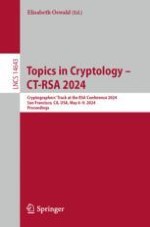2024 | Buch
Topics in Cryptology – CT-RSA 2024
Cryptographers’ Track at the RSA Conference 2024, San Francisco, CA, USA, May 6–9, 2024, Proceedings
herausgegeben von: Elisabeth Oswald
Verlag: Springer Nature Switzerland
Buchreihe : Lecture Notes in Computer Science
